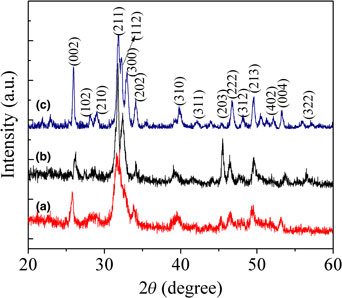Crossref Citations
This article has been cited by the following publications. This list is generated based on data provided by
Crossref.
Kumar, Govindan Suresh
Muthu, Devaraj
Karunakaran, Gopalu
Karthi, Sekar
Girija, Easwaradas Kreedapathy
and
Kuznetsov, Denis
2018.
Curcuma longa tuber extract mediated synthesis of hydroxyapatite nanorods using biowaste as a calcium source for the treatment of bone infections.
Journal of Sol-Gel Science and Technology,
Vol. 86,
Issue. 3,
p.
610.
Gholibegloo, Elham
Karbasi, Ashkan
Pourhajibagher, Maryam
Chiniforush, Nasim
Ramazani, Ali
Akbari, Tayebeh
Bahador, Abbas
and
Khoobi, Mehdi
2018.
Carnosine-graphene oxide conjugates decorated with hydroxyapatite as promising nanocarrier for ICG loading with enhanced antibacterial effects in photodynamic therapy against Streptococcus mutans.
Journal of Photochemistry and Photobiology B: Biology,
Vol. 181,
Issue. ,
p.
14.
Kalaiselvi, V.
Mathammal, R.
Vijayakumar, S.
and
Vaseeharan, B.
2018.
Microwave assisted green synthesis of Hydroxyapatite nanorods using Moringa oleifera flower extract and its antimicrobial applications.
International Journal of Veterinary Science and Medicine,
Vol. 6,
Issue. 2,
p.
286.
Kumar, Govindan Suresh
Karunakaran, Gopalu
Girija, Easwaradas Kreedapathy
Kolesnikov, Evgeny
Minh, Nguyen Van
Gorshenkov, Mikhail V.
and
Kuznetsov, Denis
2018.
Size and morphology-controlled synthesis of mesoporous hydroxyapatite nanocrystals by microwave-assisted hydrothermal method.
Ceramics International,
Vol. 44,
Issue. 10,
p.
11257.
Duraimurugan, J.
Kumar, G. Suresh
Maadeswaran, P.
Shanavas, S.
Anbarasan, P. M.
and
Vasudevan, V.
2019.
Structural, optical and photocatlytic properties of zinc oxide nanoparticles obtained by simple plant extract mediated synthesis.
Journal of Materials Science: Materials in Electronics,
Vol. 30,
Issue. 2,
p.
1927.
Ibraheem, Saheed Ademola
Audu, Ephraim Akuaden
Jaafar, Mas'ud
Adudu, Judy Atabat
Barminas, Jeffrey Tsware
Ochigbo, Victor
Igunnu, Adedoyin
and
Malomo, Silvia Omonirume
2019.
Novel pectin from Parkia biglobosa pulp mediated green route synthesis of hydroxyapatite nanoparticles.
Surfaces and Interfaces,
Vol. 17,
Issue. ,
p.
100360.
Karunakaran, Gopalu
Kumar, Govindan Suresh
Cho, Eun-Bum
Sunwoo, Young
Kolesnikov, Evgeny
and
Kuznetsov, Denis
2019.
Microwave-assisted hydrothermal synthesis of mesoporous carbonated hydroxyapatite with tunable nanoscale characteristics for biomedical applications.
Ceramics International,
Vol. 45,
Issue. 1,
p.
970.
Karunakaran, Gopalu
Cho, Eun-Bum
Kumar, Govindan Suresh
Kolesnikov, Evgeny
Janarthanan, Gopinathan
Pillai, Mamatha Muraleedharan
Rajendran, Selvakumar
Boobalan, Selvakumar
Gorshenkov, Mikhail Vladimirovich
and
Kuznetsov, Denis
2019.
Ascorbic Acid-Assisted Microwave Synthesis of Mesoporous Ag-Doped Hydroxyapatite Nanorods from Biowaste Seashells for Implant Applications.
ACS Applied Bio Materials,
Vol. 2,
Issue. 5,
p.
2280.
Karunakaran, Gopalu
Cho, Eun-Bum
Kumar, Govindan Suresh
Kolesnikov, Evgeny
Karpenkov, Dmitriy Yu
Gopinathan, Janarthanan
Pillai, Mamatha Muraleedharan
Selvakumar, Rajendran
Boobalan, Selvakumar
and
Gorshenkov, Mikhail V.
2019.
Sodium dodecyl sulfate mediated microwave synthesis of biocompatible superparamagnetic mesoporous hydroxyapatite nanoparticles using black Chlamys varia seashell as a calcium source for biomedical applications.
Ceramics International,
Vol. 45,
Issue. 12,
p.
15143.
Karthickraja, D.
Karthi, S.
Kumar, G. A.
Sardar, D. K.
Dannangoda, G. C.
Martirosyan, K. S.
and
Girija, E. K.
2019.
Fabrication of core–shell CoFe2O4@HAp nanoparticles: a novel magnetic platform for biomedical applications.
New Journal of Chemistry,
Vol. 43,
Issue. 34,
p.
13584.
Hariani, Poedji Loekitowati
Muryati, Muryati
Said, Muhammad
and
Salni, Salni
2020.
Synthesis of Nano-Hydroxyapatite from Snakehead (<i>Channa striata</i>) Fish Bone and its Antibacterial Properties.
Key Engineering Materials,
Vol. 840,
Issue. ,
p.
293.
Alorku, Kingdom
Manoj, M.
and
Yuan, Aihua
2020.
A plant-mediated synthesis of nanostructured hydroxyapatite for biomedical applications: a review.
RSC Advances,
Vol. 10,
Issue. 67,
p.
40923.
Varadarajan, Vijayalakshmi
Varsha, Mayya
Vijayasekaran, Keerthiga
and
Shankar, Shinde Vaibhav
2020.
Comparative studies of hydroxyapatite (HAp) nanoparticles synthesized by using different green templates.
Vol. 2240,
Issue. ,
p.
080002.
Subramanian, R
Murugan, P
Chinnadurai, G
Ponmurugan, K
and
Al-Dhabi, Naif Abdullah
2020.
Experimental studies on caffeine mediated synthesis of hydroxyapatite nanorods and their characterization.
Materials Research Express,
Vol. 7,
Issue. 1,
p.
015022.
Karunakaran, Gopalu
Cho, Eun-Bum
Kumar, Govindan Suresh
Kolesnikov, Evgeny
Janarthanan, Gopinathan
Pillai, Mamatha Muraleedharan
Rajendran, Selvakumar
Boobalan, Selvakumar
Sudha, Kattakgoundar Govindaraj
and
Rajeshkumar, Mohan Prasanna
2020.
Mesoporous Mg-doped hydroxyapatite nanorods prepared from bio-waste blue mussel shells for implant applications.
Ceramics International,
Vol. 46,
Issue. 18,
p.
28514.
J., Duraimurugan
G., Suresh Kumar
S., Shanavas
R., Ramesh
R., Acevedo
P.M., Anbarasan
and
P., Maadeswaran
2020.
Hydrothermal assisted phytofabrication of zinc oxide nanoparticles with different nanoscale characteristics for the photocatlytic degradation of Rhodamine B.
Optik,
Vol. 202,
Issue. ,
p.
163607.
Pai, Shraddha
M Kini, Srinivas
Selvaraj, Raja
and
Pugazhendhi, Arivalagan
2020.
A review on the synthesis of hydroxyapatite, its composites and adsorptive removal of pollutants from wastewater.
Journal of Water Process Engineering,
Vol. 38,
Issue. ,
p.
101574.
P. Sindhuja, P. Sindhuja
V. Kalaiselvi, V. Kalaiselvi
N. Vidhya, N. Vidhya
and
V. Ramya, V. Ramya
2020.
Green Synthesis of Psidium guajava Capped Hydroxyapatite Nanoparticles..
Journal of Environmental Nanotechnology,
Vol. 9,
Issue. 3,
p.
19.
Olajide, Jimmy Lolu
Desai, D.A.
Ajibola, J.O.
Adekoya, Gbolahan Joseph
Daramola, Oluyemi Ojo
Alaneme, K.K.
Fasiku, Victoria Oluwaseun
and
Sadiku, Emmanuel Rotimi
2020.
Antibiotic Materials in Healthcare.
p.
171.
Ali, Ashraf F.
Alrowaili, Ziyad A.
El-Giar, Emad M.
Ahmed, Manar M.
and
El-Kady, Abeer M.
2021.
Novel green synthesis of hydroxyapatite uniform nanorods via microwave-hydrothermal route using licorice root extract as template.
Ceramics International,
Vol. 47,
Issue. 3,
p.
3928.






